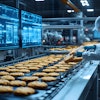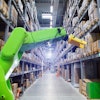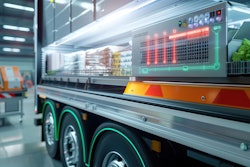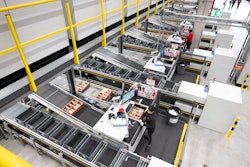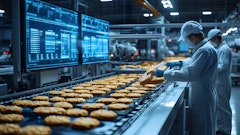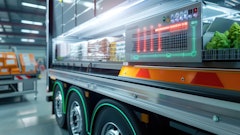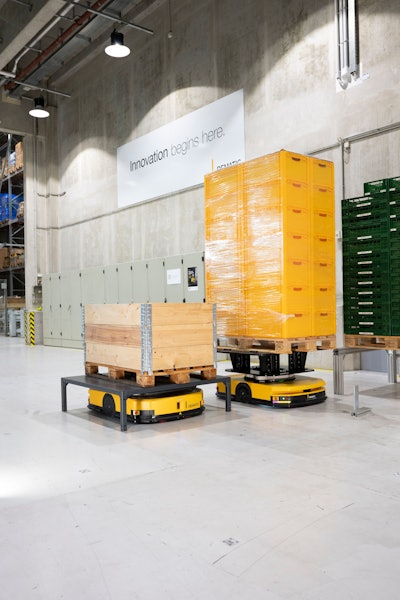
The future of warehouse automation involves emerging technologies, everything from artificial intelligence (AI) and cobots to predictive maintenance, robotics, augmented reality (AR), machine learning (ML) and more.
Present day, these automated systems are revolutionizing the way warehouses operate, driving efficiency, improving accuracy, reducing labor costs, increasing safety and more.
Food Logistics sat down exclusively with Josh Hartman, market development director, Dematic, to discuss fraud and cybersecurity challenges, entry-level autonomous solutions and what it takes to maintain a consistent temperature across the entire supply chain.
CLICK HERE to read Part 1 of this article in full. CLICK HERE to read Part 2 of this article in full. CLICK HERE to read Part 3 of this article in full.
Food Logistics: The future of warehouse automation involves emerging technologies, everything from AI and cobots to predictive maintenance and more. What are some of the key technologies and solutions every company in the cold food chain space must employ in order to future-proof their supply chains?
Josh Hartman: Maintaining a consistent temperature across the entire supply chain is perhaps the most critical requirement to ensure food remains safe to consume by the time it arrives to its destination. Due to this, Internet of Things (IoT) devices have become increasingly popular with cold chain because they offer enhanced visibility and monitoring, enabling proactive issue resolution. There are technologies in the marketplace which provide real-time visibility and tracking of movement and temperature through every step of the supply chain. In addition to tracking individual shipments, companies can aggregate that data to understand if they have recurring points of failure or even predict when a likely failure could occur and avert it entirely.
Food Logistics: Breaking down a warehouse, what parts must be automated? What parts should be automated? And what parts are difficult to automate? And why?
Hartman: Typical warehouse operations are broken down into inbound gate/yard, receiving and putaway, picking and value-added services, packing, shipping, and outbound gate/yard. When integrated into operations, automation can provide cost savings, improved accuracy, increased storage capacity, reduced risk of injury, and increased throughput. There is a broad spectrum of automation solutions, from introductory-level technologies that still require a heavy amount of human interaction to ‘lights out’ facilities that require very little intervention.
The elements in a warehouse that should be automated really depend on the company’s needs. If you’re looking to start your automation journey, ask yourself a series of questions, such as, “What problems am I seeking to solve? What storage and throughput capacity will I need five to 10 years from now? What is my current supply chain network, and will it change? What budget do I have available to invest?”
With all of that in mind, companies should:
· Focus on automating highly labor-intensive or complex manual operations, such as picking cases of product to place on a pallet or conveyor belt or preparing batches of varying SKUs for e-commerce orders. Complex tasks that require manual labor often lead to reduced accuracy.
· Consider increasing facility utilization or freeing up space to expand factory floor operations, as this is where value is being generated. This can be achieved by implementing high-density storage solutions for pallets or cases.
Another element of a warehouse that should be automated is visibility and tracking capabilities. Warehouse management systems (WMS) provide visibility into inventory, order management, and basic functionality, such as aging reports to identify products at end-of-shelf life.
The food and beverage industry utilizes relatively standard products, such as palletized or bulk (silos), that lend themselves to automation. However, unlike other manufacturing operations that handle oversized goods, food and beverage warehouses sometimes store flammable foods and chemicals that require higher standard fire suppression. Though automation is achievable, it requires more planning and investment.
Food Logistics: How do certain rules and regulations (i.e., the FSMA 204 rule) denote how, where and when companies should be automating their warehouses?
Hartman: FSMA 204 requires the food and beverage industry to maintain certain information about food that is considered to be high risk. The primary objective of this regulation is to ensure food safety by increasing transparency and requiring traceability records. This regulation does not specifically require automated solutions, but technology and automation are often ideal to ensure timely and consistent compliance. Required Key Data Elements such as origin information, transformation information, shipping information, receiving details, and more would be highly difficult to accomplish through manual or semi-automated processes. Blockchain technologies are emerging as a powerful tool to help companies comply with FSMA requirements.
Food Logistics: What advice do you have for those companies who haven’t implemented any automation whatsoever or are just starting the journey? Where/how should they start?
Hartman: For companies looking to start an automation journey, their first steps will depend on a typical product/order profile, the problems they’re looking to solve, where the business will be in 5-10 years, and the automation budget. Some entry-level automation solutions are smaller investments, such as automated guided vehicles (AGVs) and autonomous mobile robots (AMRs), robotic palletizers and de-palletizers, layer pick solutions, voice-picking solutions, and more. The usage of AGVs and AMRs to convey pallet-sized loads throughout the warehouse is a relatively low risk entry into automation while still significantly lowering labor costs. Another good entry point into automation is integrating existing operations with software. For example, a robust WMS manages inventory, a warehouse execution system (WES) will manage the flow and assignment of work, and a control tower will monitor and alert you to changes in product trends or performance. However, while these are great solutions for specific needs, it’s critical to understand not only where your business is and what it needs today, but what it will likely need in the future to maximize the return on investment.
Food Logistics: With cargo fraud and cybersecurity on the rise, what could possibly happen to those company who don’t invest in warehouse automation?
Hartman: While fraud and cybersecurity are challenges for every business, the key concern for food and beverage companies is to ensure the safety of their products and therefore the safety of raw materials, commodities, and ingredients used to manufacture products. However, thorough tracking and tracing capabilities (which are typically based on lot or batch number) as well as a strong a vendor approval process can minimize the risk of food contamination. Companies without robust WES and WMS tracking and tracing capabilities and strong vendor approval systems and processes open themselves up for significant product recalls, liability, and most importantly, losing significant customer confidence and credibility.
Food Logistics: Within the last 12 months, what technologies or solutions has your company introduced?
Hartman: As a member of the KION Group, Dematic is collaborating with NVIDIA and Accenture in a recently announced partnership focusing on AI-powered solutions and digital twin technology. Leveraging Dematic next generation cloud native software and NVIDIA “Mega” Omniverse, this partnership will allow customers to enhance and optimize operations through modeling simulations.
For the food and beverage industry, and specifically cold chain, high-density storage is important to maximize your footprint and keep the temperature consistent. The more open a freezer warehouse, the more warm airflow from outside can create temperature variances. High-density storage solutions such as pallet crane-based automated storage and retrieval systems (AS/RS) and pallet shuttle technology offer scalability, multiple SKUs per put-away lane, and even higher throughput. To continue providing these solutions to customers, KION recently signed an extensive partnership with one of the leading pallet shuttle providers, Eurofork.
Food Logistics: What are some things not addressed above that may be pertinent to our cold food chain readers?
Hartman: SKU proliferation is a natural outcome of evolving consumer preferences, such as growing demand for healthier options and specific regional flavors. As the volume of SKUs increases, manual methods of assigning each SKU a picking location become more challenging and require more floor space. Incorporating high ceiling storage and automated retrieval with goods-to-person fulfillment stations will maximize available floor space without requiring a picking location for every SKU.
It's also worth noting that cold chain warehouses require a much higher capital expenditure than ambient or air-conditioned warehouses, making ‘down time’ much more crucial. The inventory loss due to ‘down time’ can create significant profit losses and impacts the ability to fulfill orders throughout the entire supply chain. Because of this, preventive maintenance is even more important in this industry and requires real-time performance monitoring of equipment that can alert an engineer of impending break down.


